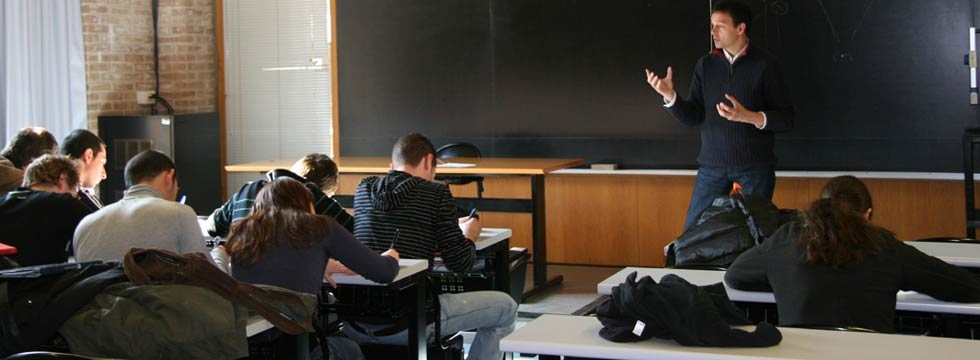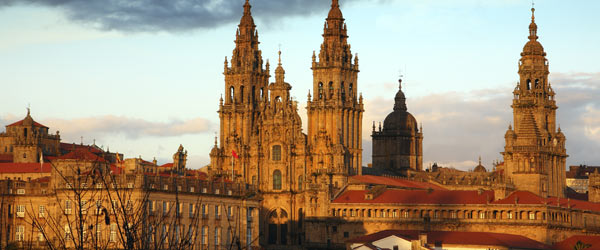A day of culture in Santiago de Compostela
Thousands of people make their way to Santiago de Compostela with one single goal in mind: to see its cathedral, the ultimate destination on the Way of Saint James. On our day of culture in the city, we will of course visit this monumental work of art, but we'll also have time for much, much more. We'll sample the lively atmosphere in its historic quarter (declared a World Heritage site by the UNESCO), try some delicious typical dishes, stroll around its peaceful gardens, and take a look at the modern art in its museums.
Morning
Cathedral of Santiago Apóstol
(approx. one hour – suggested timetable: 9-10 am.)
There is only one way to start off a day out in Santiago: in the Cathedral. We go in through the door leading from the Obradoiro square, where pilgrims will already have been arriving from far and wide since the early hours of the morning. The first thing to meet our eyes is the Gloria doorway. Behind the mullion people can be seen performing a curious ritual: knocking their heads three times (gently) on the statue of Master Mateo. This custom originates from the university students who used to do this to increase their intelligence and for good luck in their exams. Another version says that if you make three wishes, one of them will come true. Who knows?, but just in case...
We follow the traditional route in our tour of the cathedral and go down into to the crypt, which contains the remains of the apostle. We then go up to the main altar to embrace the statue of Santiago and to get a different and less common view of the cathedral. As we go through the ambulatory, we will see the Holy Door, which is only opened in Holy Years (when 25 July falls on a Sunday). Going through this doorway is a very .
Things to remember
In the summer months and in a Holy Year (when 25 July falls on a Sunday), it is a good idea to be patient, as the number of people who visit Santiago de Compostela is considerably higher.
Cathedral roofs
(45 min. approx. – suggested timetable: 10-10:45 am.)
We decide to take the guided tour of the cathedral roofs, which allows us to climb to the very top of the building and look out over the historic centre from the heights. To do so we make for the Gelmírez Palace, located to the side of the cathedral in the Plaza del Obradoiro square. This itinerary takes us through the interior of the Gelmírez Palace, past the cathedral gallery (above the Gloria doorway) and up to the roofs of the cathedral.
The sensation of the wind on your face, this elevated vantage point, the view… it will all leave you speechless.
Things to remember
Visits to the roofs are in groups, every hour on the hour. If you wish to take the tour in English, you need to say so in advance.
To make sure you can visit the cathedral at your preferred time, the best idea is to reserve the tickets beforehand by phone (+34 902557812), or on the website http://www.catedraldesantiago.es/, then pick up the tickets at the entrance a little before the tour begins.
Church and Monastery of San Martín Pinario
(45 min. approx. – suggested timetable: 11-11:45 am.)
Behind the cathedral as we go out through the Azabachería door we reach the Plaza de la Inmaculada square with the church of San Martín Pinario.
The features worth noting in the interior include the old restored walnut wood choirstalls from the cathedral.
Pilgrims' Mass
(Midday)
We return to the cathedral to attend the Pilgrims' Mass. This is celebrated daily at midday, and during the ceremony a welcome is extended to all the pilgrims who have completed the Way of Saint James, with a mention of their place of origin.
What's more, if it is a Holy Year, you'll have the chance to see the famous botafumeiro, or ceremonial incense burner in action. This event is very moving and spectacular: it requires several people to swing the great thurible, and the aroma it gives off is particularly evocative.
To be sure of a good view and so as not to miss anything, the best place to stand is in the transept.
Things to remember
When the botafumeiro is in operation the celebration becomes very crowded, so it's a good idea to arrive early if you want a decent view.
The botafumeiro is swung every day during the Pilgrims' Mass in the Jacobean years. The rest of the time it is on display in the Cathedral Museum, and the ritual is celebrated only on certain solemn events (25 July and religious festivities), or when expressly requested by a group.
If, when visiting the Cathedral, you ever find it placed on the main altar, this is a sign that either that day or the next (depending on the time) in the Pilgrims' Mass, the great thurible will be seen flying through the air above the cathedral transept.
Midday
(Suggested timetable: 12:45-3:30 pm.)
Cathedral area
After mass, we take a quiet walk around the squares around the cathedral (Quintana, Platerías, Obradoiro) to observe the details of each façade, and capture them for posterity with our camera.
Shopping and lunch in the historic quarter
We walk towards the streets of Rúa do Franco and Rúa do Villar in the old part of town, the site of the tourist office and the pilgrims' centre, and home to a host of businesses and shops selling crafts, souvenirs, clothing, food... even small book and antique markets. Silver and jet are typical local purchases, as well as everything to do with the Way of Saint James and the Apostle (botafumeiros, scallop shells, staffs…). Also ceramics, leather, classical Galician bagpipes, and witches or "meigas" (the word for witch in Galicia).
Parallel to these streets there are another two shopping areas: the Rúa Nova and the Rúa Calderería, which are frequented by the inhabitants of Santiago for their everyday purchases. We make a brief stop in the Rúa do Franco to see the Renaissance cloister in the Fonseca College, which houses the library of the University of Santiago. There are also numerous bars and restaurants in this area.
We can stop and have lunch whenever we like, and order some portions to share and the typical local dishes. Good suggestions include the pulpo a feira (octopus), gammon with turnip greens or potatoes, empanada (savoury filled pastry), marinated pork, squid, Padrón peppers (only in season, and look out! some are searingly hot), steamed mussels, fish stew, pote (traditional Galician bean stew), fish and shellfish. And all accompanied by Galician wine (for example, Ribeiro or Albariño). For dessert, we can order a classic combination: Santiago almond tart and orujo liqueur (traditional orujo is colourless, but other flavours include herbs, cream, coffee…).
Afternoon
Alameda Park
(Suggested timetable: 3:30-5 pm.)
After lunch, we can continue along the streets of Franco and Villar towards the Alameda Park for about ten minutes. We can take a leisurely stroll around its stately tree-lined paths, and look at the fountains, sculptures and buildings (Santa Susana chapel, the music pavilion, the dovecote…). As we'll be fairly high up, we'll also have an outstanding view over the city. The park is connected to the gardens of the university campus by a flight of steps, so let's go and take a look.
A route around the city
(Suggested timetable: 5-6 pm.)
Now we go back to the centre, but along an alternative route so as to pass in front of the Geography and History Faculty, the church of San Fiz de Solivio and the building which houses the Mercado de Abastos, or general produce market.
We then continue on along towards the Bonaval park in order to visit two of the city's museums. On our way we'll pass the convent of San Agustín, the church of Santa María del Camino and the El Camino gateway.
Suggestion
The market opens in the mornings, and the busiest days are Thursday and Saturday. It's well worth a visit if you're planning to stay any longer in Santiago. You'll find all kinds of fresh foods, typical products, cured sausages and meats, flowers, fabrics… And notice the vendors who set up outside the market: they're usually women from nearby towns who come to sell their home-grown produce from their vegetable gardens.
Museum of the Galician People and the Galician Contemporary Art Centre
(Suggested timetable: 6-7:45 pm.)
Now we enter the site formed by the Church and Convent of Santo Domingo de Bonaval, which also houses the Museum of the Galician People. The most curious feature is the triple spiral staircase which leads to the different floors of the building, and makes a good subject for a photo.
Now, it's time to change styles and go to the Galician Contemporary Art Centre next door. This building is modern both inside and out, and was designed by the eminent architect Álvaro Siza.
Night
We leave the museums behind and return to the cathedral. The idea is to see it illuminated by night, and this will take no more than 20 minutes. We walk through the Puerta del Camino gateway, the Plaza de Cervantes square and the Calle de la Azabachería until we come to San Martín Pinario.
We spend some time in the Plaza del Obradoiro taking in the impressive sight of the illuminated buildings arranged all around the square: the cathedral, the Reyes Católicos Parador, the Rajoy Palace and the College of San Jerónimo.
We deserve a hearty dinner after our day out, so let's find a restaurant where we can enjoy a delicious dish of shellfish, fish, or rice.
After dinner, what about a little music while we enjoy a drink? In the area around the historic centre there are several bars and pubs which have an inviting atmosphere and décor.







